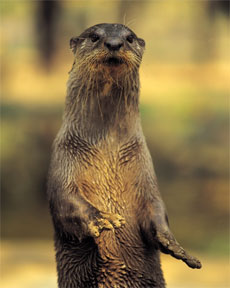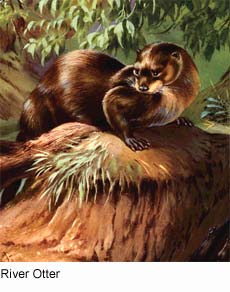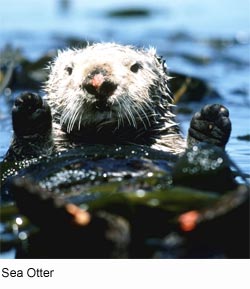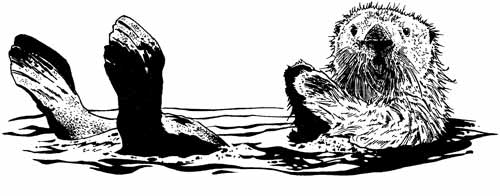|

 A Hairy Situation: Otters have a dense layer of very soft underfur (650,000 hairs per sq. in), in addition to an outer layer of long guard hairs. This dense pelt keeps them dry under water and traps a layer of air to keep them warm. A Hairy Situation: Otters have a dense layer of very soft underfur (650,000 hairs per sq. in), in addition to an outer layer of long guard hairs. This dense pelt keeps them dry under water and traps a layer of air to keep them warm.
Swimmers' Bodies: All otters have long, slim, streamlined bodies of extraordinary grace and flexibility, and short limbs; in most cases they have webbed paws. Most have sharp claws to grasp prey, but the short-clawed otter of southern Asia has only vestigial claws, and two closely-related species of African otter have no claws at all: these species live in the often muddy rivers of Africa and Asia and locate their prey by touch.

Something's Fishy: Most otters have fish as the primary item in their diet, supplemented by frogs, crayfish and crabs; some have become expert at opening shellfish, and others will take any available small mammals or birds.
Pray for Prey: Otters have very high metabolic rates and burn up energy at a quick pace. Eurasian otters, for example, must eat 15% of their body-weight a day; sea otters, 20 to 25%, depending on the temperature.
 This prey-dependence leaves otters very vulnerable to prey depletion. In water as warm as 10°C an otter needs to catch 100 g of fish per hour: less than that and it cannot survive. Most species hunt for 3 to 5 hours a day, nursing mothers up to 8 hours a day. This prey-dependence leaves otters very vulnerable to prey depletion. In water as warm as 10°C an otter needs to catch 100 g of fish per hour: less than that and it cannot survive. Most species hunt for 3 to 5 hours a day, nursing mothers up to 8 hours a day.
The Northern river otter (Lontra canadensis) became one of the major animals hunted and trapped for fur in North America after European contact. As one of the most playful and active species of otter, they have become a popular exhibit in zoos and aquaria, but unwelcome on agricultural land because they alter river banks for access, sliding, and defense.
Just the Facts: River otters eat a variety of fish and shellfish, as well as small land mammals and birds. They grow to 1 m (3 to 4 feet) in length and weigh from 5 to 15 kg (10 to 30 pounds). Once found all over North America, they have become rare or extinct in most places, although flourishing in some locations.
Some jurisdictions have made otters a protected species, and some places have otter sanctuaries. These sanctuaries help ill and injured otters to recover.
Sea otters (Enhydra lutris) live along the Pacific coast of North America. Their historic range included shallow waters of the Bering Strait and Kamchatka, and as far south as Japan. Sea otters have some 200,000 hairs per square cm of skin, a rich fur for which humans hunted them almost to extinction.
 The Sea Otters are Back! By the time the 1911 Fur Seal Treaty gave them protection, so few sea otters remained that the fur trade had become unprofitable. The Sea Otters are Back! By the time the 1911 Fur Seal Treaty gave them protection, so few sea otters remained that the fur trade had become unprofitable.
Just the Facts II: They eat shellfish and other invertebrates (especially clams, abalone, and sea urchins), and one can frequently observe them using rocks as crude tools to smash open shells.
Sizes and Scales: They grow to 1 to 2 m (2.5 to 6 feet) in length and weigh 30 kg (25 to 60 pounds). Although once near extinction, they have begun to spread again, starting from the California coast.
Blubberless: Unlike most marine mammals (seals, for example, or whales), sea otters do not have a layer of insulating blubber. As with other species of otter, they rely on air-pockets trapped in their fur.
Otters in Danger: Otters also inhabit in Europe. In the United Kingdom they occurred commonly as recently as the 1950s, but have now become rare due to the former use of chlorinated hydrocarbon pesticides and as a result of habitat-loss. Numbers reached a low point in the 1980s, but with the aid of a number of initiatives, by 1999 estimated numbers indicated a recovery to just below 1,000 animals. The UK Biodiversity Action Plan envisages the re-introduction of otters by 2010 to all the UK rivers and coastal areas that they inhabited in 1960. Roadkill deaths have become one of the significant threats to the success of their re-introduction.

All text is available under the terms
of the GNU Free Documentation License
|